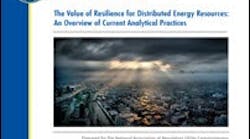The Value of Resilience for Distributed Energy Resources: An Overview of Current Analytical Practices
This report was developed based upon funding from the Alliance for Sustainable Energy, LLC, Managing and Operating Contractor for the National Renewable Energy Laboratory (NREL) for the U.S. Department of Energy (DOE). Funding provided by U.S. Department of Energy Office of Energy Efficiency and Renewable Energy Solar Energy Technologies Office. The views expressed herein do not necessarily represent the views of the DOE or the U.S. Government.
This paper is written as an input to a broader project by the National Association of Regulatory Utility Commissioners (NARUC) under the Solar Energy Innovation Network (SEIN). NARUC’s SEIN project focuses on the value of resilience and its use in state policymaking. NARUC has previously explored the topic of resilience as it relates to electricity regulation (Keogh & Cody, 2013). NARUC has also explored opportunities for improved electric grid resilience in the face of “black sky” hazards that can cause long-duration power interruptions (Stockton, 2014). In parallel, NARUC has developed a manual for state utility regulators on rate design and compensation models for distributed energy resources (DERs) (NARUC, 2016). NARUC’s SEIN research builds on these previous efforts by investigating whether and how current state DER policies support resilience objectives. The overall goal of the NARUC SEIN project is to provide state regulators with guidance for taking resilience into account when evaluating investments in DERs.
This report was prepared by Converge Strategies, LLC (CSL), a consulting firm working at the intersection of resilience, advanced energy, and national security. CSL was founded in 2017 and has offices in Boston and Washington, D.C. CSL connects rapidly emerging technologies to the resilience objectives of the military, utilities, and state and local governments. www.convergestrategies.com.
